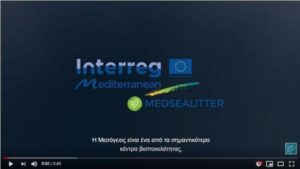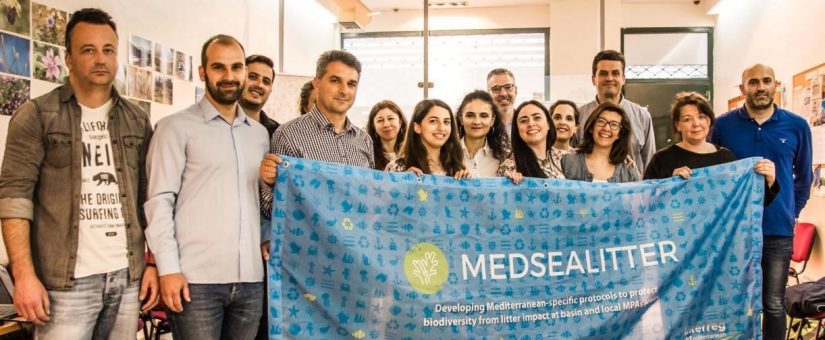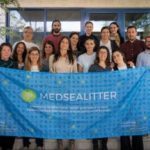October 5, 2020
83 organisations advocate for biodiversity conservation in the Mediterranean!
The three-year environmental Interreg project – MEDSEALITTER (2017-2019), which aimed at developing and adopting common protocols for monitoring marine litter and its harmful impacts on important species in the Mediterranean, has successfully been completed. The project was implemented in the framework of the INTERREG MED 2014-2020 program, with the collaboration of 11 environmental organisations from 4 European countries: Spain, France, Italy and Greece. In Greece, MEDASSET and the Hellenic Center for Marine Research HCMR participated in the project.
Key outcome of the project was the creation of a new, easy-to-use tool: the Common Monitoring Protocol for marine litter. 83 organizations in Greece and more than 300 in all 4 countries involved, have already adopted the protocol. The adoption of MEDSEALITTER protocol is a key step towards the protection of the Mediterranean biodiversity.
Prompted by the recent publication “Evidence of ingested plastics in stranded loggerhead sea turtles along the Greek coastline, East Mediterranean Sea”, published in the Environmental Pollution Journal, in which MEDASSET participated, we present the results from project’s activities which are directly related to the EU Directive 2019/904, concerning the adverse effects of the single use plastics.
Hereby you can watch the video of the MEDSEALITTER project: https://youtu.be/HLmvIqjNyhY
Within the framework of the MEDSEALITTER project, three participatory workshops took place in Greece, aiming at introducing the protocol to the participants and provide training: in Kavala (16/5), in Patras (22/5) and in Athens (6/6/2019), hosted by the Fisheries Research Institute- INALEE, the Ecological Movement of Patras – OIKIPA and HCMR respectively and with the significant contribution of Dr. Komnenou Anastasia, Professor of Veterinary School in the Aristotle University of Thessaloniki.
More than 100 representatives of Marine Protected Areas Management Bodies, Local Governmental Authorities, NGOs, Universities, Fisheries Departments, Port Authorities, as well as veterinarians, biologists and other relevant stakeholders attended the workshop.
It is worth highlighting the most significant scientific data that emerged from the implementation of the project:
- Concerning the monitoring of macro and micro-litter ingested at large and local MPAs scales: on large or local scales:
- The sea turtle (Caretta caretta) was selected as the best bioindicator to monitor marine litter ingested by biota at large scale. The examination of the samples revealed that out of 133 turtles more than 70% had ingested plastic.
- The examination of 750 ‘Boops boops’ samples revealed plastic ingestion in a percentage of 51.1% (in particular 1086 plastic objects were found in 383 fish).2. UAV (Unmanned Aerial Vehicle) Observations (automatic photography).
2. Over an area of 111 sq. km, 97 objects of floating macro-litter were observed.
3. Large vessel-based observations in high sea revealed an average of 50 macro-litter items larger than 20 cm per km2.
4. Medium and small vessel-based observations revealed an average of 50 macro-litter items larger than 20 cm per km2.
In order for the project’s overall results and activities to be evaluated and for the protocol to be disseminated, a final meeting took place in Rome on 11-12 June 2019. Representatives of the European Union, national and international governmental bodies and environmental organisations from Greece, France, Italy and Spain attended the meeting, advocating for the importance of the protocol.
- Nadia Andreanidou, MEDASEALITTER Project Officer for MEDASSET stated: “According to the data, it’s beyond doubt that marine litter and especially plastics pose great pressure to sea turtles. Presenting the results of the project in United Nations Mediterranean Action Plan (UNEP/MAP) international meetings, we emphasized that sea turtles should be a bio-indicator species for assessing the marine Good Environmental Status. MEDASSET’s recommendation has been adopted by UNEP/MAP and Caretta caretta sea turtle is now a bio-indicator species for assessing the Good Environmental Status of marine ecosystems contributing to the Greek National Marine Strategy Action Plan”
- Mr. Georgios Markopouliotis, Head of the Representation of the European Commission in Greece stated: “The European Green Deal is not a luxury, it’s our guide for overcoming the crisis caused by Corona Virus, which is more than economic. Τhe “green growth” is not only feasible but necessary. We are the first generation that is experiencing climate change effects in its daily life and we maybe the last that can actually do something about it.
- Professor of the Veterinary School AUTH, Ms. Anastasia Komnenou, on behalf of the Aristotle University of Thessaloniki, noted: “Necropsies often reveal high concentrations of plastics ingested by animals, resulting in a slow and devastating death. I find the protocol to be an important and useful tool for veterinarians and biologists. In this way, we document the impact of plastics on various marine species in order to adopt measures to protect these animals. Uniformity would not be achieved otherwise”.
- Mr. George Melekis, on behalf of the Special Secretariat for Water of the Ministry of Environment, highlighted: “The development of methοdological protocols, specifications and standardized methods for monitoring the criteria set by the Marine Strategy Framework Directive (MSFD) is of crucial importance. This way the results of survey can be horizontally accepted by the scientific community and the EU Bodies without any subjectivity elements. The necessary time for the protocols to be incorporated into the review of the Greek Marine Monitoring Network is being given (within 2020), following the suggestions of the implementing bodies, always within the timeframe set by the EU Marine Strategy Framework Directive (MSFD).
- Eleni Kamperi, Chemical Oceanographer of the Hellenic Center for Marine Research, stated: “In the framework of MEDSEALITTER project, HCMR quantified, for the first time, plastics that were ingested by sea turtles. We continue to investigate, in the framework of other European projects, the effects of plastics on animals’ health, in order to demonstrate the importance of putting into force the legislation in relation to the sea turtles’ monitoring on a regular basis.
- Lydia Alvanou, Biodiversity Monitoring officer of Thermaikos Gulf Protected Areas Management Authority emphasized: “For us dealing with environmental management, the monitoring protocol is an invaluable tool. There is a common ground that we all discuss and work on. It is well-documented, tested and helps me to further contribute to the conservation of natural capital.”
- The original protocol – MARINE LITTER MONITORING PROTOCOL
- Organizations and other stakeholders implementing the project:
- MEDASSET – GREECE
- Hellenic Centre for Marine Research (HCMR) – GREECE
- Capo Carbonara MPA Comune di Villasimius – ITALY
- Cinque Terre National Park and Marine Protected Area – ITALY
- École Pratique des Hautes Études (EPHE) – FRANCE
- EcoOcéan Institut – FRANCE
- Italian National Institute for Environmental Protection and Research (ISPRA) – ITALY
- Legambiente ONLUS – ITALY
- University of Barcelona – SPAIN
- University of Valencia – SPAIN





Comments are closed.